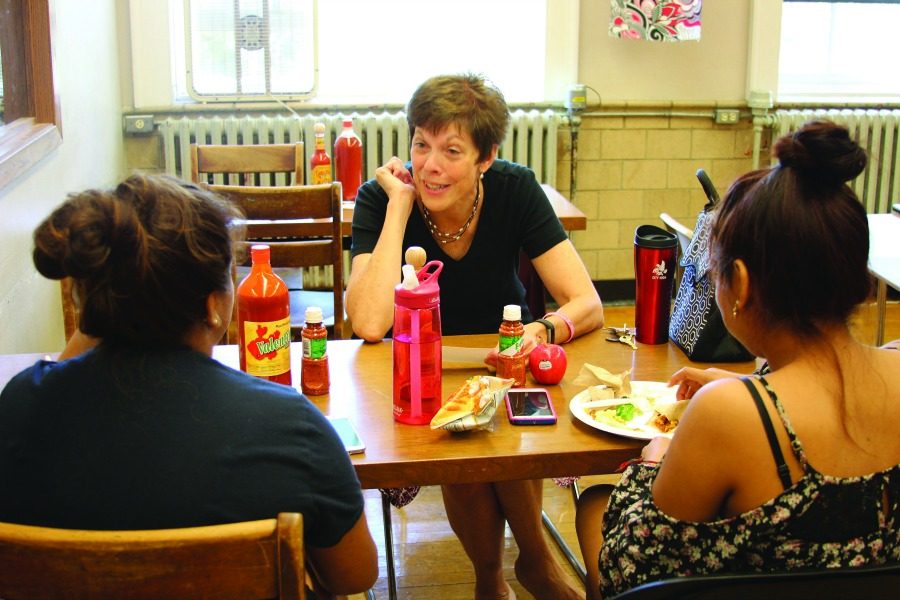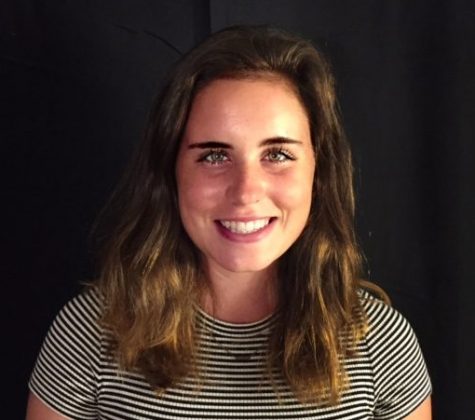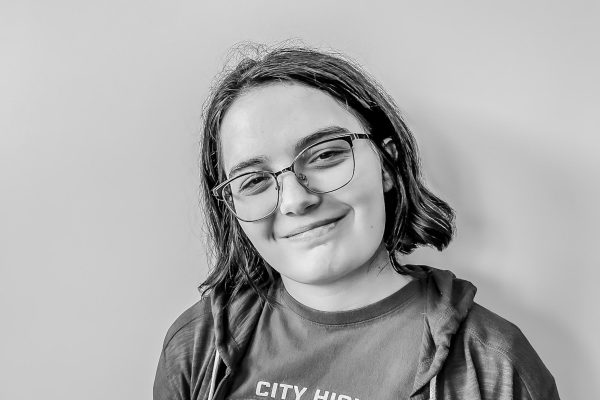Spanish Café Opens
Beatriz Gemartino ’17 and Estefanie Gracia-Rojas ’17 converse with Biology teacher Tina Koepnick
October 4, 2016
What started simply as hot sauce stored in a drawer in Success Center teacher Ann Schaefer’s drawer has grown to an entire lunch period of Spanish emersion.
“Last year, students approached me wanting a place to call their own,” Schaefer said. “I already had the hot sauce so more and more students starting coming in to hang out.”
The Spanish Café takes place during all lunches on Tuesdays in Schaefer’s room, 1114. Students and faculty can sit down at desks arranged into groups of four, complete with “Valentina” hot sauce and flashcards with conversation starters. Beatriz Gemartino ‘17 routinely eats lunch in Schaefer’s room, and also is a native Spanish speaker.
“I have to practice my spanish too, so this is a good opportunity. I actually met knew people, so it’s a good way to meet new friends as well,” Gemartino said. “We’re helping the non-native speakers, and they’re helping us too.”
Sadie Hobbs ‘17 also eats lunch frequently in Schaefer’s room and has participated in the past two Spanish Cafés.
“I think it’s a really good idea because it brings us together. It’s a way to practice Spanish and get to know other Spanish speakers,” Hobbs said. “You can learn about other people’s cultures that got to City High that speak Spanish at home. It’s a really good thing to participate in.”
Although the café on the outside seems to be a workshop for those still learning Spanish, it also has many advantages to fluent speakers.
“[The native speakers] will be able to share their strengths with others. They will be able to connect with community numbers to see where those skills have taken them,” Schaefer said. “Hopefully they’ll be able to have more ideas of what they can do with their language skills in their future and at the same time feel like they are the ones in the classroom that feel like leaders, and are in charge of the whole environment.
Teachers with the desire to learn Spanish or already know it also make an appearance during the lunch hour to conversate with students.
“So many of the teachers have skills that students don’t know,” Schaefer said. “The other students can see their teachers use their skills and even learn or understand that they’re learning too. It gives them that want and drive to want to learn too.”
Along with faculty, Schaefer plans on bringing in bilingual community leaders.
“The ultimate goal is to get students to feel honored and respected that they are bilingual, and to see where their use of strengths can get them in the future,” Schaefer said. “That’s why bringing in community members, that use their language and are part of businesses promotes diversity, while teaching is used to help them feel comfortable and proud that they have that skill.”
The Café allows students to incorporate the practice of Spanish in a the familiar lunch setting. Cyan Vanderhoef ‘17 is a student in AP Spanish IV/V and acknowledges the benefits of the immersive environment.
“I think it’s good to normalize spanish conversation. We never really go out of our way to do it,” Vanderhoef said. “It forces us into a situation that we’re not used to but eventually it’ll become normal for us and will help us improve our skills outside of the classroom.”
Spanish 2 Honors and AP Spanish IV/V teacher Danielle Eivins worked with Schaefer with the creation of the Café.
“I like it a lot. I met new students and they were very nice,” Eivins said in Spanish. “I like it because it is not like a class; it is calmer. We do need more people, though.”
Food ultimately binds both cultures together over the lunch hour. Mexican flavor twists like the “Valentina” hot sauce and “Tajin” seasoning reside on tables for the optional flavor adventure. The “Tajin” seasoning is traditionally put on fruit for a salty and sweet sensation, and the hot sauce is put on anything edible. Estefanie Garcia-Rojas ‘17 was one of the first students to make use of the original hot sauce drawer that led to the all lunch period affair.
“Valentina” is my life. I can’t eat without it. It is delicious,” Garcia-Rojas said. “There’s a whole bunch of food that [non-native speakers] would love.”
Hispanic culture is taught in many different forms in Spanish classes. Textbooks, worksheets, and videos among others are used to engage the students in the vivacious life styles of other Spanish speaking countries. However, much of that culture is just a few steps outside of the classroom door.
“I think what’s different here rather than in Spanish class, where they teach you some of the culture and stuff about Mexico, is here you get to see it and hear it, and see how an individual is,” Gemartino said. “Like Estefanie said, she puts hot sauce on everything. It’s those little things.”
































